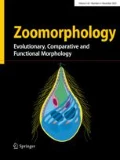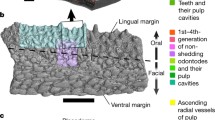Summary
The formation of echinoderm endoskeletons is studied using echinoid teeth as an example. Echinoid teeth grow rapidly. They consist of many calcareous elements each produced by syncytial odontoblasts. The calcification process in echinoderms needs (1) syncytial sclerocytes or odontoblasts, (2) a spacious vacuolar cavity within this syncytium, (3) an organic matrix coat in the cavity. As long as calcite is deposited, the matrix does not touch the interior face of the syncytium. The cooperation between syncytium, interior cavity and matrix coat during the mineralization process is discussed. The proposed hypothesis applies to the formation of larval skeletons, echinoderm ossicles and echinoid teeth.
When calcite deposition ceases the syncytium largely splits up into filiform processes, and the skeleton is partly exposed to the extracellular space. However, the syncytium is able to reform a continuous sheath and an equivalent of the cavity and may renew calcite deposition.
The tooth odontoblasts come from an apical cluster of proliferative cells, each possessing a cilium. The cilium is lost when the cell becomes a true odontoblast. This suggests that cilia are primitive features of echinoderm cells. The second step in calcification involves the odontoblasts giving rise to calcareous discs which unite the hitherto single tooth elements. During this process the odontoblasts immure themselves. The structures necessary for calcification are maintained until the end of the process.
The mineralizing matrix is EDTA-soluble. The applied method preserves the matrix coating the calcite but more is probably incorporated into the mineral phase and dissolved with the calcite.
Similar content being viewed by others
Abbreviations
- A :
-
adhesive point (LNC)
- B :
-
adaxial bag
- bb :
-
basal body (ci)
- CA :
-
calcareous deposits
- cb :
-
cytoplasmic bladder (cp)
- ce :
-
centriole
- ci :
-
cilium
- cp :
-
cable-like cell process
- cv :
-
condensing vacuole
- dp :
-
distal processes (sh)
- E :
-
epithelium of the tooth
- ex :
-
extracellular space
- f :
-
extracellular fibrils
- ga :
-
gasket (sh)
- ic :
-
interior cavity
- L :
-
lamellae (LNC)
- LNC :
-
lamellae needle complex
- m :
-
mitochondrium
- mc :
-
matrix coat
- MF :
-
main fold (P)
- MI :
-
mitosis
- mt :
-
microtubules
- N :
-
nucleus
- O :
-
odontoblast
- P :
-
primary plate
- Ph :
-
phagocyte
- PR :
-
proliferative cell
- pr :
-
prism
- rb :
-
reserve body
- RER :
-
rough endopl. reticulum
- rl :
-
rootlet (ci)
- RY :
-
relatively youngest plate
- s :
-
satellite (bb, ce)
- sh :
-
synplasmic sheath (O)
- SP :
-
secondary plate
- sv :
-
smooth-walled vesicle
- TF :
-
transversal fold (P)
- U :
-
umbo (P)
- v :
-
Golgi vesicle
- Y :
-
youngest tooth element
References
Blankenship J, Benson S (1984) Collagen metabolism and spicule formation in sea urchin micromeres. Exp Cell Res 152:98–104
Burkhardt A, Hansmann W, Märkel K, Niemann HJ (1983) Mechanical design in spines of diadematoid echinoids. Zoomorphology 102:189–203
Chen CP (1985) The role of carbonic anhydrase in the calcification of the tooth of the sea urchin Lytechinus variegatus. Ph.D-Dissertation, University of South Florida
Emlet RB (1982) Echinoderm calcite: A mechanical analysis from larval spicules. Biol Bull 163:264–275
Gibbins JR, Tilney LG, Porter KR (1969) Microtubules in the formation and development of the primary mesenchyme in Arbacia punctulata. I. The distribution of microtubules. J Cell Biol 41:201–226
Holland ND (1965) An autoradiographic investigation on tooth renewal in the purple sea urchin (Strongylocentrotus purpuratus). J Exp Zool 158:275–282
Inoué S, Okazaki K (1977) Biocrystals. Sci Amer 236:83–92
Karnovsky MJ (1971) Use of ferrocyanide-reduced osmium tetroxide in electron microscopy. Abstracts of the Am Soc of Cell Biol. Rockefeller University Press, New York, New Orleans, p 146
Kemp NE (1984) Organic matrices and mineral crystallites in vertebrate scales, teeth and skeletons. Am Zool 24:965–976
Kingsley RJ (1984) Spicule formation in the invertebrates with special reference to the gorgonian Leptogorgia virgulata. Am Zool 24:883–891
Kingsley RJ, Watabe N (1982) Ultrastructural investigation on spicule formation in the gorgonian Leptogorgia virgulata. Cell Tissue Res 223:325–334
Kingsley RJ, Watabe N (1984) Synthesis and transport of the organic matrix of the spicules in the gorgonian Leptogorgia virgulata. Cell Tissue Res (1984) 235:533–538
Kniprath E (1974) Ultrastructure and growth of the sea urchin tooth. Calcif Tissue Res 14:211–228
Lennarz WJ (1985) Regulation of glycoprotein synthesis in the developing sea-urchin embryo. Trends in Biochem Sci 10:248–251
Märkel K, Titschack H (1969) Morphologie der Seeigelzähne. I. Der Zahn von Stylocidaris affinis. Z Morphol Tiere 64:179–200
Märkel K, Gorny P, Abraham K (1977) Microarchitecture of sea urchin teeth. Fortschr Zool 24:103–114
Märkel K, Röser U (1983a) The spine tissues in the echinoid Eucidaris tribuloides. Zoomorphology 103:25–41
Märkel K, Röser U (1983b) Calcite resorption in the spine of the echinoid Eucidaris tribuloides. Zoomorphology 103:43–58
Märkel K, Röser U (1985) Comparative morphology of echinoderm calcified tissues: Histology and ultrastructure of ophiuroid scales. Zoomorphology 105:197–207
Millonig G (1970) A study on the formation and structure of the sea urchin spicule. J Submicrosc Cytol 2:157–165
Okazaki K (1975a) Normal development to metamorphosis. In: Czihak G (ed) The sea urchin embryo. Springer, Berlin Heidelberg New York
Okazaki K (1975b) Spicule formation by isolated micromeres of the sea urchin embryo. Am Zool 15:567–581
O'Neill PL (1981) Polycrystalline echinoderm calcite and its fracture mechanics. Science 213:646–648
Pearse JS, Pearse VB (1975) Growth zones in the echinoid skeleton. Am Zool 15:731–753
Pilkington JB (1969) The organization of skeletal tissues in the spines of Echinus esculentus. J Mar Biol Assoc UK 49:857–877
Weiner S (1984) Organization of organic matrix components in mineralized tissues. Am Zool 24:945–951
Weiner S (1985) Organic matrixlike macromolecules associated with the mineral phase of sea urchin skeletal plates and teeth. J Exp Zool 234:7–15
Wilbur KM, Saleuddin ASM (1983) Shell formation. In: Wilbur K (ed) The Mollusca, Vol. 4. Academic Press, New York London, pp 236–287
Author information
Authors and Affiliations
Rights and permissions
About this article
Cite this article
Märkel, K., Röser, U., Mackenstedt, U. et al. Ultrastructural investigation of matrix-mediated biomineralization in echinoids (Echinodermata, Echinoida). Zoomorphology 106, 232–243 (1986). https://doi.org/10.1007/BF00312044
Received:
Issue Date:
DOI: https://doi.org/10.1007/BF00312044




